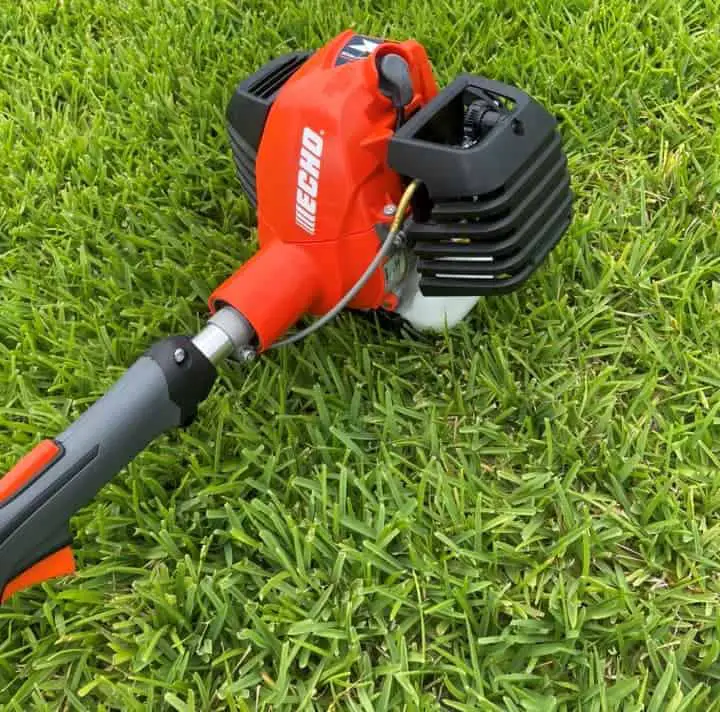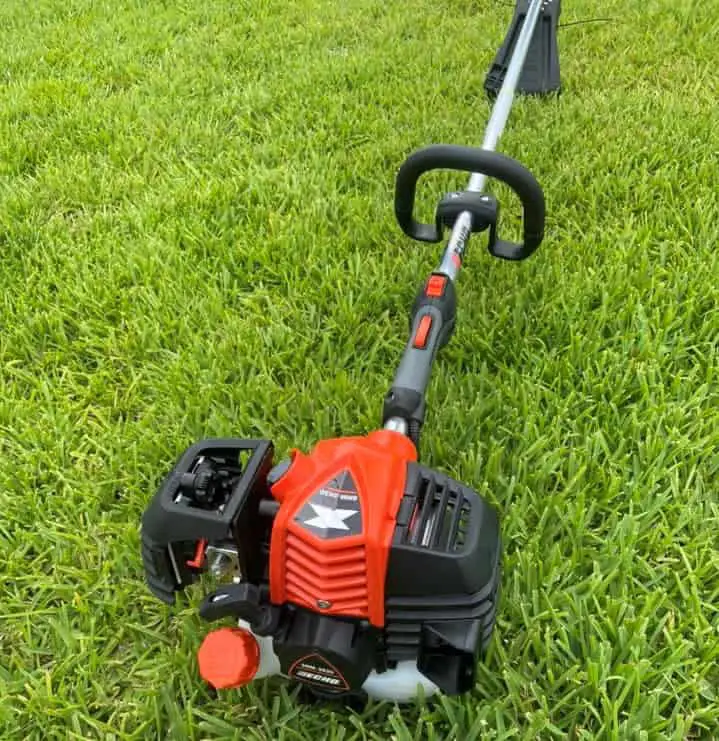Good day!
Have you ever wondered just how fast a string trimmer spins? Like many lawn owners, I’ve found myself pondering this question as well. After digging into some serious research, and discovering that the average weed eater spins around 7000 RPM, I’ve now got all the answers you’re looking for.
This blog will not just tell you about the spin speed but also reveal important factors affecting it and tips to ensure optimal performance. It’s time to rev things up!
Contents
Key Takeaways
- The rotation speed of a string trimmer can vary between 3000 to 15000 RPM.
- Factors such as the power source (electric or petrol), model and brand, and the quality and length of the string can affect the speed at which a string trimmer spins.
- Choosing a powerful string trimmer that matches your property size and vegetation type is important for efficient trimming without straining the machine.
- Thicker lines provide more cutting power, while nylon strings are durable and resistant to wear and tear.
- Issues with the clutch, housing, shaft, or electrical faults could cause a non – spinning trimmer head. Prompt troubleshooting is necessary to ensure peak performance.
How Fast Does A String Trimmer Spin?
The rotation speed of a string trimmer can vary between 3000 to 15000 rpm. 7000 rpm on average
3000 to 15000 rpm. 7000 rpm on average
The spinning power of a string trimmer is quite remarkable, with some models rotating as fast as 15,000 RPM. To put this into perspective, imagine a lightweight object making thousands of circles in just one minute – that’s the trimming prowess you can wield.
However, not all trimmers are created equal; some may offer a more laid-back spin rate closer to 3000 RPM. This slower speed still brings adequate strength for everyday lawn maintenance tasks and is common among certain makes or models.
It’s fascinating to note that at full throttle, your trimmer head might whip around at nearly 400 miles per hour! Despite this range in rotation rates, what matters most is how effectively the tool meets your landscaping needs.
Read more: Why Your Trimmer Head Spins at Idle Wildly? Find out the Reasons

Factors Affecting String Trimmer Speed
Several factors can affect the speed of a string trimmer, including the power source, model and brand, as well as the quality and length of the string. Want to learn more about how these factors impact your trimming experience? Keep reading!
Power source (electric or petrol)
The power source of a string trimmer, whether electric or petrol, significantly influences its spinning speed. Electric trimmers typically run on amps, which directly impacts their cutting prowess.
You’ll find that these models tend to deliver cleaner and more efficient performance than their petrol counterparts – think zero emissions and no risk of fuel spillage. For instance, the Ego ST1511T stands out as an affordable battery-powered string trimmer that matches gas tool standards without the messy fuel or major upkeep hassles.
On the other hand, if you’re looking for proven reliability over time, a gas-powered weed eater might serve you better despite its potential environmental impact. Remember how fast a string trimmer spins also defines how effectively it cuts grass; hence your decision can affect your lawn’s ultimate look!
Model and brand
In the realm of string trimmers, not all models and brands are created equal. Some tend to excel more than others in terms of power, efficiency, and speed – which greatly influences how fast your string trimmer spins.
Established brands like Ego and STIHL have a reputation for delivering high-performance machines. Take for instance, the Ego ST1511T; it’s known for reliably spinning at impressive speeds even when taming overgrown fields.
A key point to keep in mind is that opting for these reputable brands often equates to equipment that performs optimally. So yes, the specific model you choose can indeed play a significant role in your trimmer’s spin rate.
String quality and length
Having the right string quality and length is crucial for the performance of your string trimmer. The quality of the string affects its durability and cutting ability, while the length determines how efficiently it can trim your lawn.
It’s recommended to use high-quality nylon strings that are specifically designed for trimming grass and weeds. These strings are capable of withstanding high speeds and provide clean cuts.
As for the length, it depends on your specific trimming needs, but most homeowners find that a 0.080-inch diameter string works well for general lawn maintenance. Remember, using the correct string quality and length will ensure optimal performance from your trimmer and give you excellent results every time you mow your lawn.
Read more: Why Does My Trimmer Line Keep Coming Out?

Conclusion
In conclusion, the speed at which a string trimmer spins can vary. On average, it rotates at around 7000 rpm, but some models can go as slow as 3000 rpm or even slower. Factors such as power source, model and brand, and the quality and length of the string can affect its speed.
Understanding the rotation speed of a string trimmer is crucial in selecting the right tool for your lawn maintenance needs.
FAQs
How Powerful Should String Trimmer Be?
As a lawn owner, it’s important to understand the power needed for your string trimmer to effectively maintain your yard. The power of a string trimmer is determined by its engine’s horsepower and torque.
Ideally, you should choose a trimmer with enough power to handle the size of your property and the type of vegetation you need to tackle.
A more powerful string trimmer will have a higher RPM (revolutions per minute), allowing it to spin faster and cut through tougher grass and weeds with ease.
When deciding how powerful your string trimmer should be, consider factors such as the size of your property and its terrain. If you have a larger yard or dense vegetation, opting for a higher horsepower and torque will ensure efficient trimming without straining the machine.
In addition to considering power, also think about noise levels and pollution preferences. Electric string trimmers are quieter and produce zero emissions compared to petrol-powered ones.
So if noise is a concern or if you’re environmentally conscious, an electric model might be more suitable for you.
Remember that the gauge of the trimmer line used also plays a role in determining how powerful your device needs to be. Thicker lines require more engine power due to their increased resistance when cutting through grass or weeds.
By choosing an appropriately powerful string trimmer based on these factors, you’ll be well-equipped to keep your lawn looking neat and tidy throughout the year without unnecessary strain or frustration.

What Is Strongest String For A Trimmer?
When it comes to finding the strongest string for your trimmer, you’ll want to consider a few factors. First and foremost, the thickness of the trimmer line plays a significant role in its strength.
Thicker lines generally offer more cutting power and durability, making them ideal for heavy-duty trimming tasks.
In addition to thickness, the material composition of the trimmer string is another important factor. Nylon strings are commonly used due to their durability and resistance to wear and tear.
Some brands even offer twisted trimmer lines that provide extra cutting power and longevity.
It’s also worth noting that certain brands may have their own specific trimmer lines designed to work optimally with their models. For example, Ego offers their unique set of compatible trimmer strings.
To ensure efficient cutting performance, choose a strong string that can withstand thicker weeds and grass without easily breaking or wearing down. By selecting a durable trimmer line with an appropriate thickness for your trimming needs, you can keep your lawn looking well-maintained all season long.
Why Is Trimmer Head Not Spinning?
One common issue that lawn owners may encounter is when the trimmer head of their string trimmer is not spinning, even when the engine is running. There can be several reasons behind this problem.
One possibility could be a malfunctioning clutch, which prevents the trimmer head from engaging with the spinning motion of the engine. Another reason could be issues with the housing or shaft, causing a blockage or interference in the movement of the trimmer head.
To troubleshoot this problem, it’s important to check if there are any visible signs of damage or wear on these components. If you notice any abnormalities, it might be necessary to replace them to restore proper functioning.
Additionally, make sure that there are no tangles or knots in the string line that could be hindering its rotation.
When dealing with electric grass trimmers specifically, another possible cause for a non-spinning trimmer head could be an electrical fault in either the motor or power supply. In such cases, professional assistance may be required for repairs.
Remember to always prioritize safety and consult your user manual before attempting any maintenance or repairs on your string trimmer. By addressing these potential issues promptly and effectively troubleshooting them, you can ensure that your string trimmer operates at peak performance and gets your lawn looking its best.





